Analysis of theories and models of curriculum and development Assignment PDF
VerifiedAdded on 2021/07/28
|17
|5179
|250
AI Summary
Contribute Materials
Your contribution can guide someone’s learning journey. Share your
documents today.
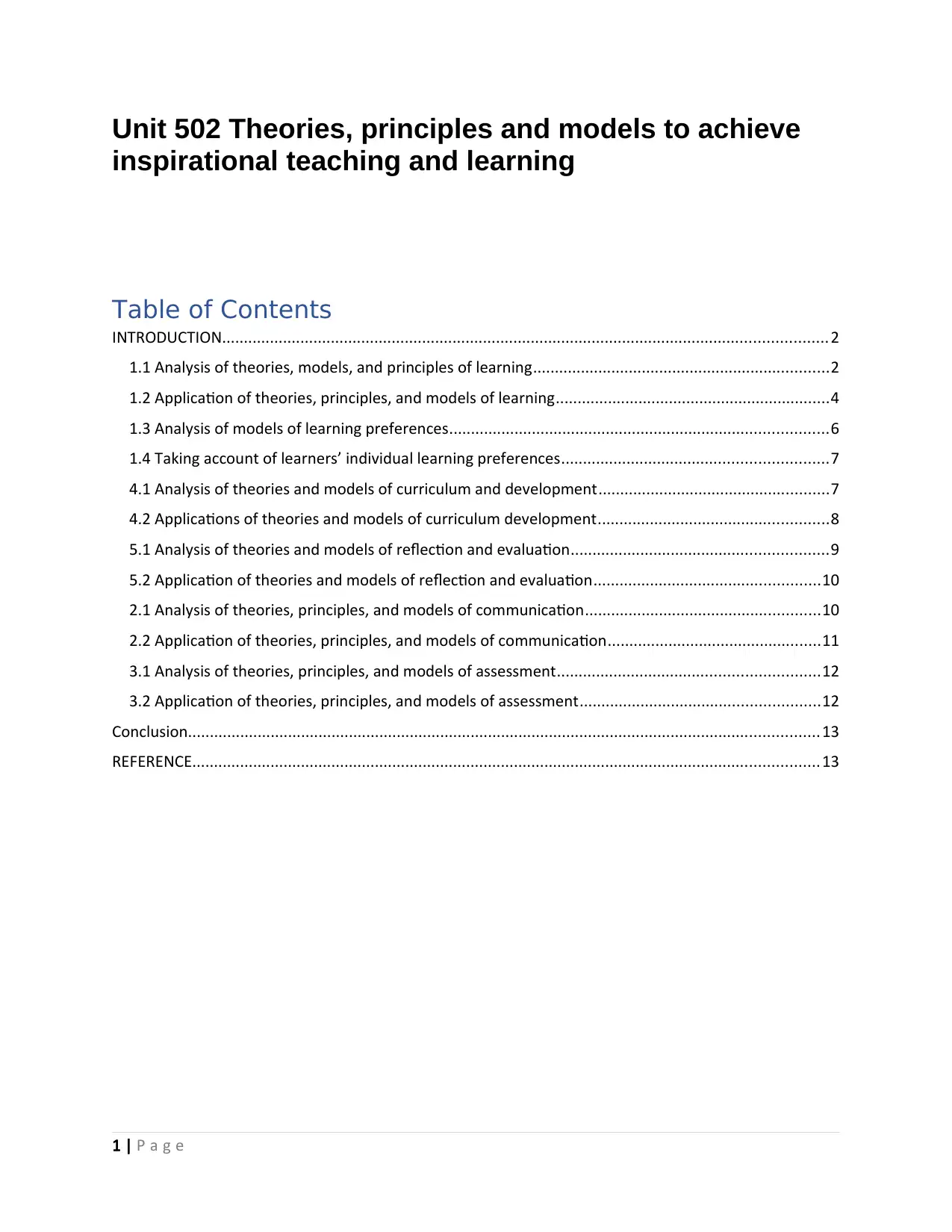
Unit 502 Theories, principles and models to achieve
inspirational teaching and learning
Table of Contents
INTRODUCTION...........................................................................................................................................2
1.1 Analysis of theories, models, and principles of learning....................................................................2
1.2 Application of theories, principles, and models of learning...............................................................4
1.3 Analysis of models of learning preferences.......................................................................................6
1.4 Taking account of learners’ individual learning preferences.............................................................7
4.1 Analysis of theories and models of curriculum and development.....................................................7
4.2 Applications of theories and models of curriculum development.....................................................8
5.1 Analysis of theories and models of reflection and evaluation...........................................................9
5.2 Application of theories and models of reflection and evaluation....................................................10
2.1 Analysis of theories, principles, and models of communication......................................................10
2.2 Application of theories, principles, and models of communication.................................................11
3.1 Analysis of theories, principles, and models of assessment............................................................12
3.2 Application of theories, principles, and models of assessment.......................................................12
Conclusion.................................................................................................................................................13
REFERENCE................................................................................................................................................13
1 | P a g e
inspirational teaching and learning
Table of Contents
INTRODUCTION...........................................................................................................................................2
1.1 Analysis of theories, models, and principles of learning....................................................................2
1.2 Application of theories, principles, and models of learning...............................................................4
1.3 Analysis of models of learning preferences.......................................................................................6
1.4 Taking account of learners’ individual learning preferences.............................................................7
4.1 Analysis of theories and models of curriculum and development.....................................................7
4.2 Applications of theories and models of curriculum development.....................................................8
5.1 Analysis of theories and models of reflection and evaluation...........................................................9
5.2 Application of theories and models of reflection and evaluation....................................................10
2.1 Analysis of theories, principles, and models of communication......................................................10
2.2 Application of theories, principles, and models of communication.................................................11
3.1 Analysis of theories, principles, and models of assessment............................................................12
3.2 Application of theories, principles, and models of assessment.......................................................12
Conclusion.................................................................................................................................................13
REFERENCE................................................................................................................................................13
1 | P a g e
Secure Best Marks with AI Grader
Need help grading? Try our AI Grader for instant feedback on your assignments.
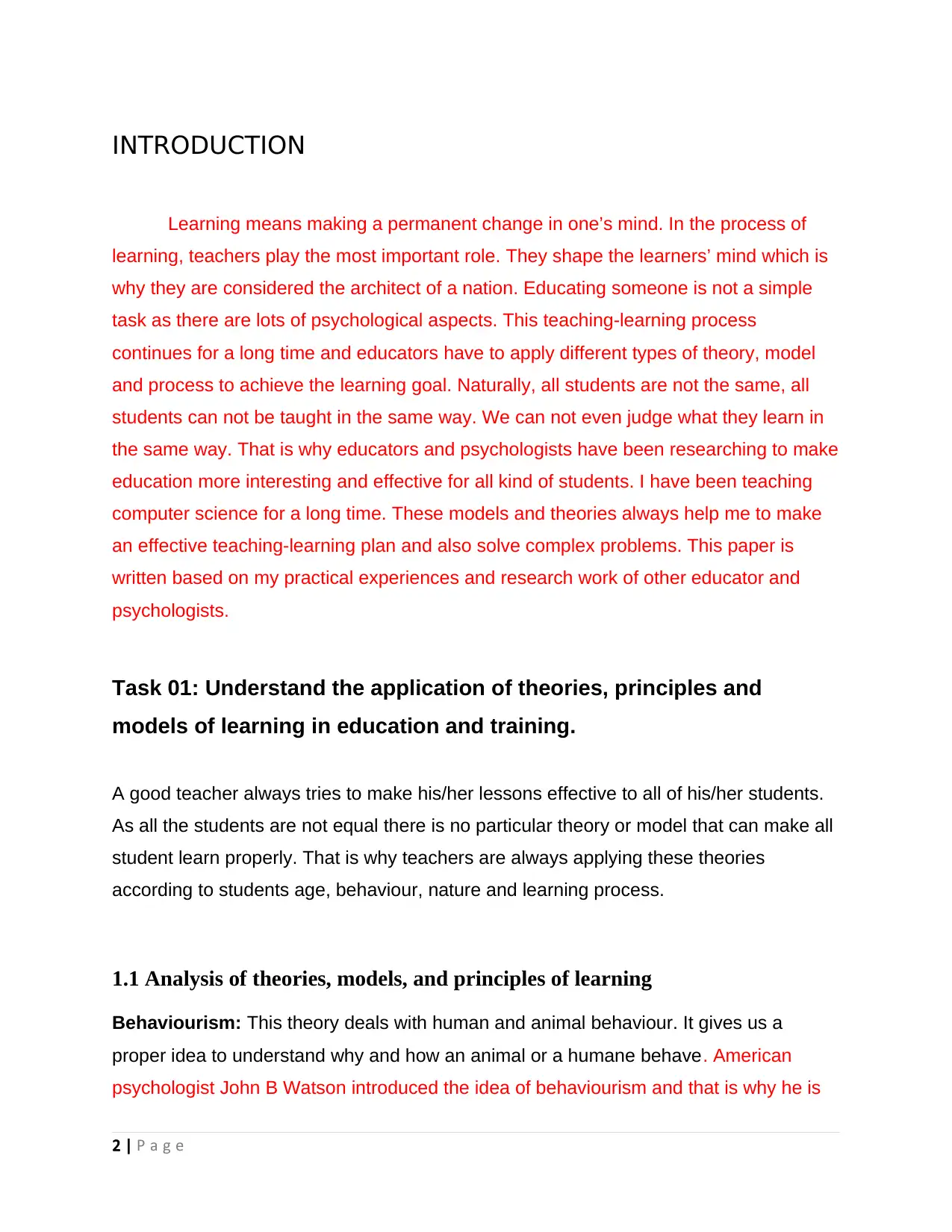
INTRODUCTION
Learning means making a permanent change in one’s mind. In the process of
learning, teachers play the most important role. They shape the learners’ mind which is
why they are considered the architect of a nation. Educating someone is not a simple
task as there are lots of psychological aspects. This teaching-learning process
continues for a long time and educators have to apply different types of theory, model
and process to achieve the learning goal. Naturally, all students are not the same, all
students can not be taught in the same way. We can not even judge what they learn in
the same way. That is why educators and psychologists have been researching to make
education more interesting and effective for all kind of students. I have been teaching
computer science for a long time. These models and theories always help me to make
an effective teaching-learning plan and also solve complex problems. This paper is
written based on my practical experiences and research work of other educator and
psychologists.
Task 01: Understand the application of theories, principles and
models of learning in education and training.
A good teacher always tries to make his/her lessons effective to all of his/her students.
As all the students are not equal there is no particular theory or model that can make all
student learn properly. That is why teachers are always applying these theories
according to students age, behaviour, nature and learning process.
1.1 Analysis of theories, models, and principles of learning
Behaviourism: This theory deals with human and animal behaviour. It gives us a
proper idea to understand why and how an animal or a humane behave. American
psychologist John B Watson introduced the idea of behaviourism and that is why he is
2 | P a g e
Learning means making a permanent change in one’s mind. In the process of
learning, teachers play the most important role. They shape the learners’ mind which is
why they are considered the architect of a nation. Educating someone is not a simple
task as there are lots of psychological aspects. This teaching-learning process
continues for a long time and educators have to apply different types of theory, model
and process to achieve the learning goal. Naturally, all students are not the same, all
students can not be taught in the same way. We can not even judge what they learn in
the same way. That is why educators and psychologists have been researching to make
education more interesting and effective for all kind of students. I have been teaching
computer science for a long time. These models and theories always help me to make
an effective teaching-learning plan and also solve complex problems. This paper is
written based on my practical experiences and research work of other educator and
psychologists.
Task 01: Understand the application of theories, principles and
models of learning in education and training.
A good teacher always tries to make his/her lessons effective to all of his/her students.
As all the students are not equal there is no particular theory or model that can make all
student learn properly. That is why teachers are always applying these theories
according to students age, behaviour, nature and learning process.
1.1 Analysis of theories, models, and principles of learning
Behaviourism: This theory deals with human and animal behaviour. It gives us a
proper idea to understand why and how an animal or a humane behave. American
psychologist John B Watson introduced the idea of behaviourism and that is why he is
2 | P a g e
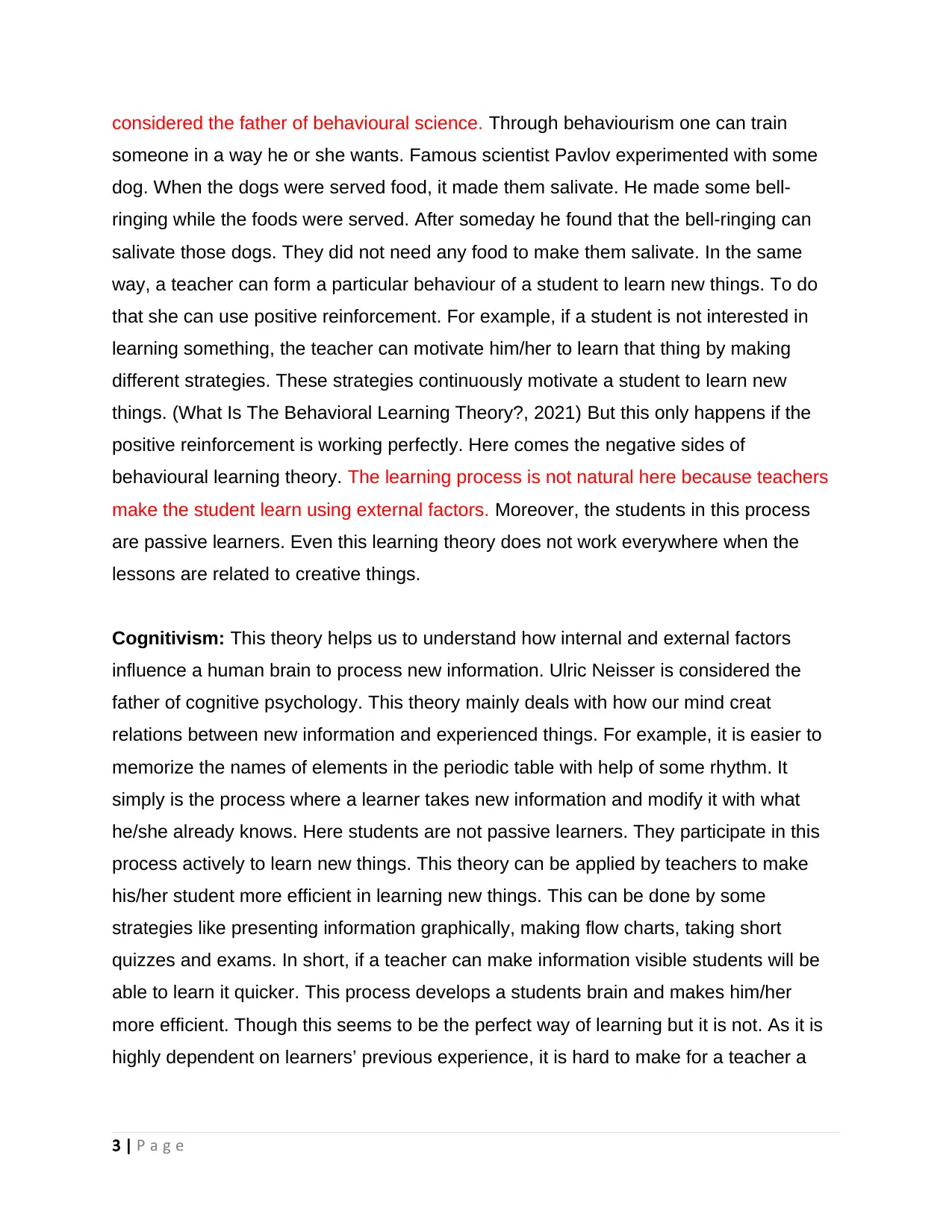
considered the father of behavioural science. Through behaviourism one can train
someone in a way he or she wants. Famous scientist Pavlov experimented with some
dog. When the dogs were served food, it made them salivate. He made some bell-
ringing while the foods were served. After someday he found that the bell-ringing can
salivate those dogs. They did not need any food to make them salivate. In the same
way, a teacher can form a particular behaviour of a student to learn new things. To do
that she can use positive reinforcement. For example, if a student is not interested in
learning something, the teacher can motivate him/her to learn that thing by making
different strategies. These strategies continuously motivate a student to learn new
things. (What Is The Behavioral Learning Theory?, 2021) But this only happens if the
positive reinforcement is working perfectly. Here comes the negative sides of
behavioural learning theory. The learning process is not natural here because teachers
make the student learn using external factors. Moreover, the students in this process
are passive learners. Even this learning theory does not work everywhere when the
lessons are related to creative things.
Cognitivism: This theory helps us to understand how internal and external factors
influence a human brain to process new information. Ulric Neisser is considered the
father of cognitive psychology. This theory mainly deals with how our mind creat
relations between new information and experienced things. For example, it is easier to
memorize the names of elements in the periodic table with help of some rhythm. It
simply is the process where a learner takes new information and modify it with what
he/she already knows. Here students are not passive learners. They participate in this
process actively to learn new things. This theory can be applied by teachers to make
his/her student more efficient in learning new things. This can be done by some
strategies like presenting information graphically, making flow charts, taking short
quizzes and exams. In short, if a teacher can make information visible students will be
able to learn it quicker. This process develops a students brain and makes him/her
more efficient. Though this seems to be the perfect way of learning but it is not. As it is
highly dependent on learners’ previous experience, it is hard to make for a teacher a
3 | P a g e
someone in a way he or she wants. Famous scientist Pavlov experimented with some
dog. When the dogs were served food, it made them salivate. He made some bell-
ringing while the foods were served. After someday he found that the bell-ringing can
salivate those dogs. They did not need any food to make them salivate. In the same
way, a teacher can form a particular behaviour of a student to learn new things. To do
that she can use positive reinforcement. For example, if a student is not interested in
learning something, the teacher can motivate him/her to learn that thing by making
different strategies. These strategies continuously motivate a student to learn new
things. (What Is The Behavioral Learning Theory?, 2021) But this only happens if the
positive reinforcement is working perfectly. Here comes the negative sides of
behavioural learning theory. The learning process is not natural here because teachers
make the student learn using external factors. Moreover, the students in this process
are passive learners. Even this learning theory does not work everywhere when the
lessons are related to creative things.
Cognitivism: This theory helps us to understand how internal and external factors
influence a human brain to process new information. Ulric Neisser is considered the
father of cognitive psychology. This theory mainly deals with how our mind creat
relations between new information and experienced things. For example, it is easier to
memorize the names of elements in the periodic table with help of some rhythm. It
simply is the process where a learner takes new information and modify it with what
he/she already knows. Here students are not passive learners. They participate in this
process actively to learn new things. This theory can be applied by teachers to make
his/her student more efficient in learning new things. This can be done by some
strategies like presenting information graphically, making flow charts, taking short
quizzes and exams. In short, if a teacher can make information visible students will be
able to learn it quicker. This process develops a students brain and makes him/her
more efficient. Though this seems to be the perfect way of learning but it is not. As it is
highly dependent on learners’ previous experience, it is hard to make for a teacher a
3 | P a g e
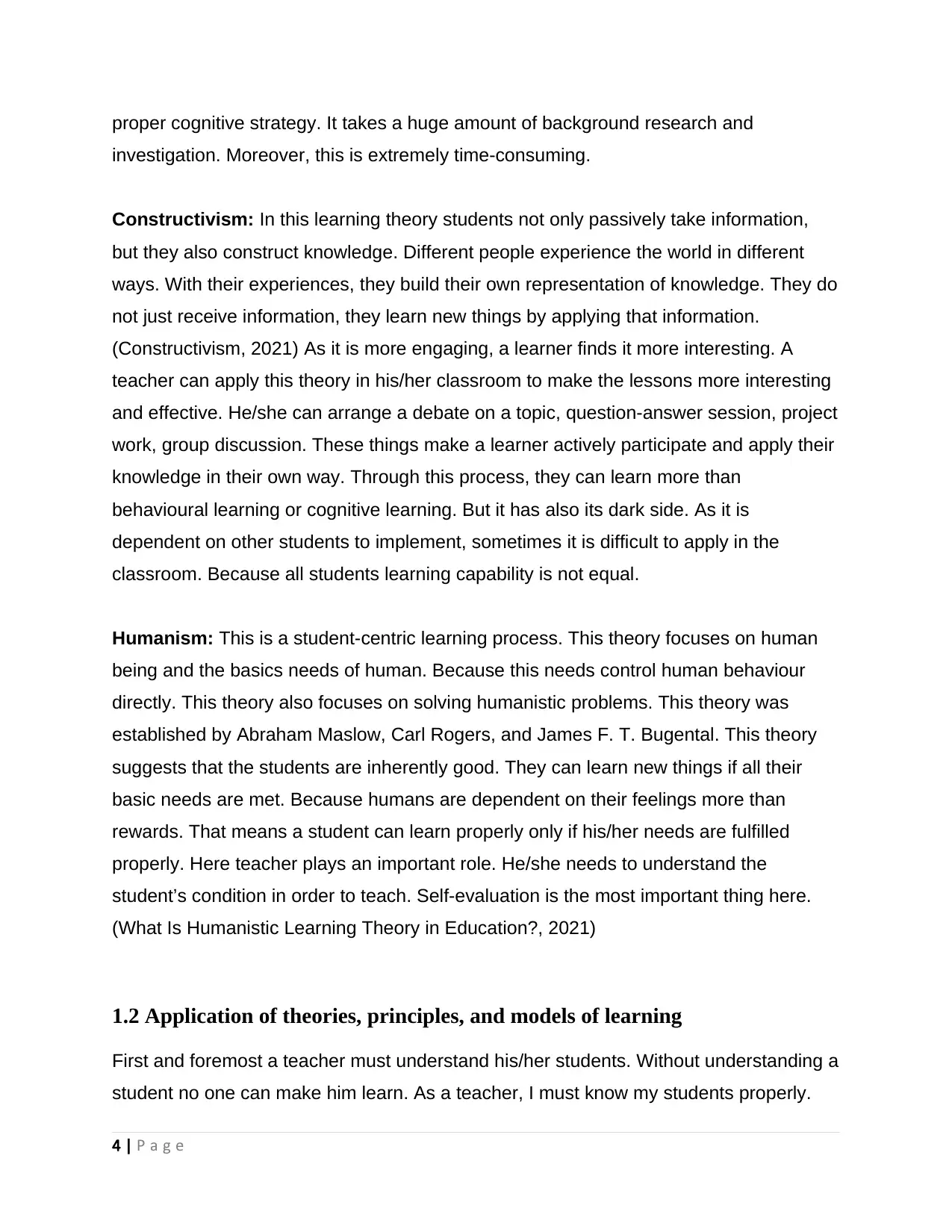
proper cognitive strategy. It takes a huge amount of background research and
investigation. Moreover, this is extremely time-consuming.
Constructivism: In this learning theory students not only passively take information,
but they also construct knowledge. Different people experience the world in different
ways. With their experiences, they build their own representation of knowledge. They do
not just receive information, they learn new things by applying that information.
(Constructivism, 2021) As it is more engaging, a learner finds it more interesting. A
teacher can apply this theory in his/her classroom to make the lessons more interesting
and effective. He/she can arrange a debate on a topic, question-answer session, project
work, group discussion. These things make a learner actively participate and apply their
knowledge in their own way. Through this process, they can learn more than
behavioural learning or cognitive learning. But it has also its dark side. As it is
dependent on other students to implement, sometimes it is difficult to apply in the
classroom. Because all students learning capability is not equal.
Humanism: This is a student-centric learning process. This theory focuses on human
being and the basics needs of human. Because this needs control human behaviour
directly. This theory also focuses on solving humanistic problems. This theory was
established by Abraham Maslow, Carl Rogers, and James F. T. Bugental. This theory
suggests that the students are inherently good. They can learn new things if all their
basic needs are met. Because humans are dependent on their feelings more than
rewards. That means a student can learn properly only if his/her needs are fulfilled
properly. Here teacher plays an important role. He/she needs to understand the
student’s condition in order to teach. Self-evaluation is the most important thing here.
(What Is Humanistic Learning Theory in Education?, 2021)
1.2 Application of theories, principles, and models of learning
First and foremost a teacher must understand his/her students. Without understanding a
student no one can make him learn. As a teacher, I must know my students properly.
4 | P a g e
investigation. Moreover, this is extremely time-consuming.
Constructivism: In this learning theory students not only passively take information,
but they also construct knowledge. Different people experience the world in different
ways. With their experiences, they build their own representation of knowledge. They do
not just receive information, they learn new things by applying that information.
(Constructivism, 2021) As it is more engaging, a learner finds it more interesting. A
teacher can apply this theory in his/her classroom to make the lessons more interesting
and effective. He/she can arrange a debate on a topic, question-answer session, project
work, group discussion. These things make a learner actively participate and apply their
knowledge in their own way. Through this process, they can learn more than
behavioural learning or cognitive learning. But it has also its dark side. As it is
dependent on other students to implement, sometimes it is difficult to apply in the
classroom. Because all students learning capability is not equal.
Humanism: This is a student-centric learning process. This theory focuses on human
being and the basics needs of human. Because this needs control human behaviour
directly. This theory also focuses on solving humanistic problems. This theory was
established by Abraham Maslow, Carl Rogers, and James F. T. Bugental. This theory
suggests that the students are inherently good. They can learn new things if all their
basic needs are met. Because humans are dependent on their feelings more than
rewards. That means a student can learn properly only if his/her needs are fulfilled
properly. Here teacher plays an important role. He/she needs to understand the
student’s condition in order to teach. Self-evaluation is the most important thing here.
(What Is Humanistic Learning Theory in Education?, 2021)
1.2 Application of theories, principles, and models of learning
First and foremost a teacher must understand his/her students. Without understanding a
student no one can make him learn. As a teacher, I must know my students properly.
4 | P a g e
Secure Best Marks with AI Grader
Need help grading? Try our AI Grader for instant feedback on your assignments.
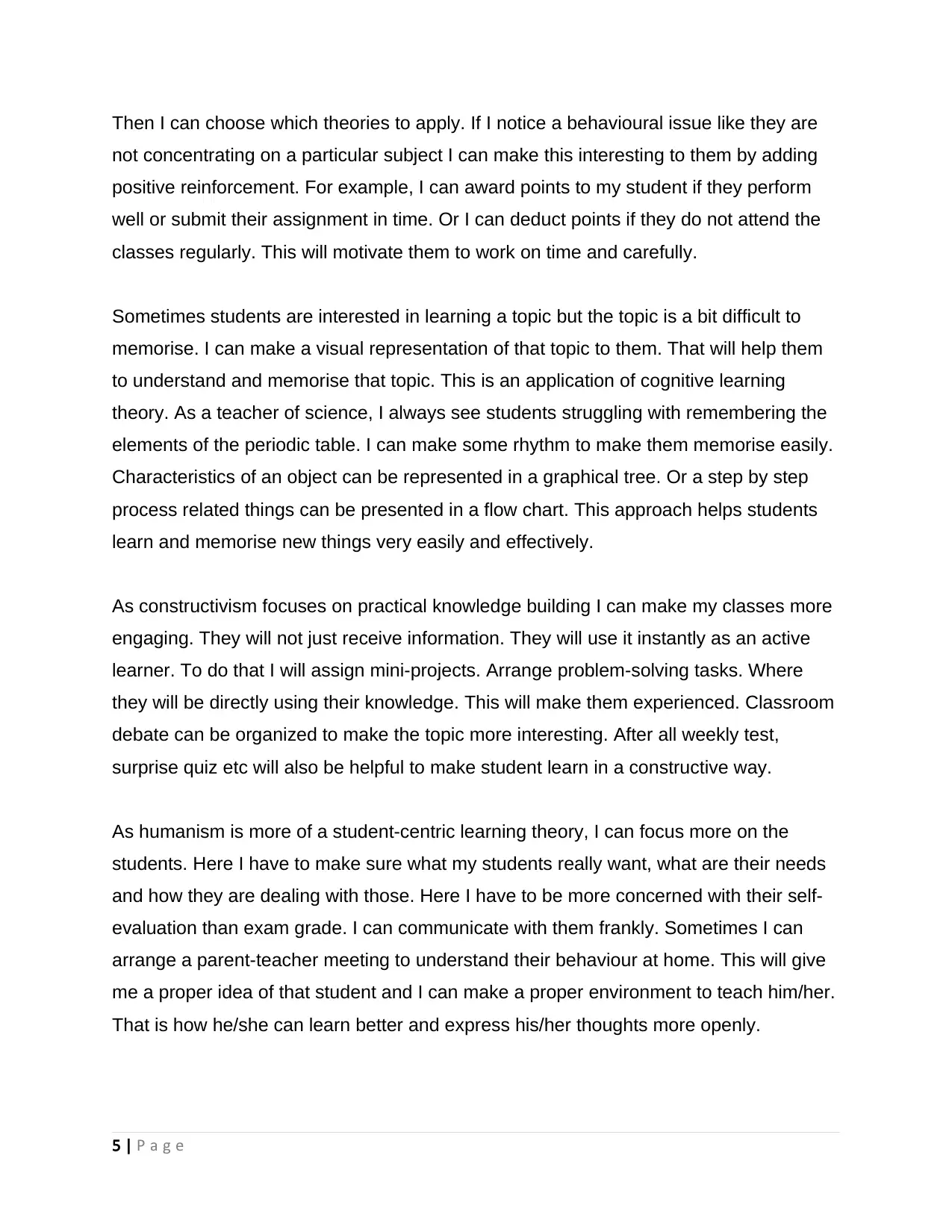
Then I can choose which theories to apply. If I notice a behavioural issue like they are
not concentrating on a particular subject I can make this interesting to them by adding
positive reinforcement. For example, I can award points to my student if they perform
well or submit their assignment in time. Or I can deduct points if they do not attend the
classes regularly. This will motivate them to work on time and carefully.
Sometimes students are interested in learning a topic but the topic is a bit difficult to
memorise. I can make a visual representation of that topic to them. That will help them
to understand and memorise that topic. This is an application of cognitive learning
theory. As a teacher of science, I always see students struggling with remembering the
elements of the periodic table. I can make some rhythm to make them memorise easily.
Characteristics of an object can be represented in a graphical tree. Or a step by step
process related things can be presented in a flow chart. This approach helps students
learn and memorise new things very easily and effectively.
As constructivism focuses on practical knowledge building I can make my classes more
engaging. They will not just receive information. They will use it instantly as an active
learner. To do that I will assign mini-projects. Arrange problem-solving tasks. Where
they will be directly using their knowledge. This will make them experienced. Classroom
debate can be organized to make the topic more interesting. After all weekly test,
surprise quiz etc will also be helpful to make student learn in a constructive way.
As humanism is more of a student-centric learning theory, I can focus more on the
students. Here I have to make sure what my students really want, what are their needs
and how they are dealing with those. Here I have to be more concerned with their self-
evaluation than exam grade. I can communicate with them frankly. Sometimes I can
arrange a parent-teacher meeting to understand their behaviour at home. This will give
me a proper idea of that student and I can make a proper environment to teach him/her.
That is how he/she can learn better and express his/her thoughts more openly.
5 | P a g e
not concentrating on a particular subject I can make this interesting to them by adding
positive reinforcement. For example, I can award points to my student if they perform
well or submit their assignment in time. Or I can deduct points if they do not attend the
classes regularly. This will motivate them to work on time and carefully.
Sometimes students are interested in learning a topic but the topic is a bit difficult to
memorise. I can make a visual representation of that topic to them. That will help them
to understand and memorise that topic. This is an application of cognitive learning
theory. As a teacher of science, I always see students struggling with remembering the
elements of the periodic table. I can make some rhythm to make them memorise easily.
Characteristics of an object can be represented in a graphical tree. Or a step by step
process related things can be presented in a flow chart. This approach helps students
learn and memorise new things very easily and effectively.
As constructivism focuses on practical knowledge building I can make my classes more
engaging. They will not just receive information. They will use it instantly as an active
learner. To do that I will assign mini-projects. Arrange problem-solving tasks. Where
they will be directly using their knowledge. This will make them experienced. Classroom
debate can be organized to make the topic more interesting. After all weekly test,
surprise quiz etc will also be helpful to make student learn in a constructive way.
As humanism is more of a student-centric learning theory, I can focus more on the
students. Here I have to make sure what my students really want, what are their needs
and how they are dealing with those. Here I have to be more concerned with their self-
evaluation than exam grade. I can communicate with them frankly. Sometimes I can
arrange a parent-teacher meeting to understand their behaviour at home. This will give
me a proper idea of that student and I can make a proper environment to teach him/her.
That is how he/she can learn better and express his/her thoughts more openly.
5 | P a g e
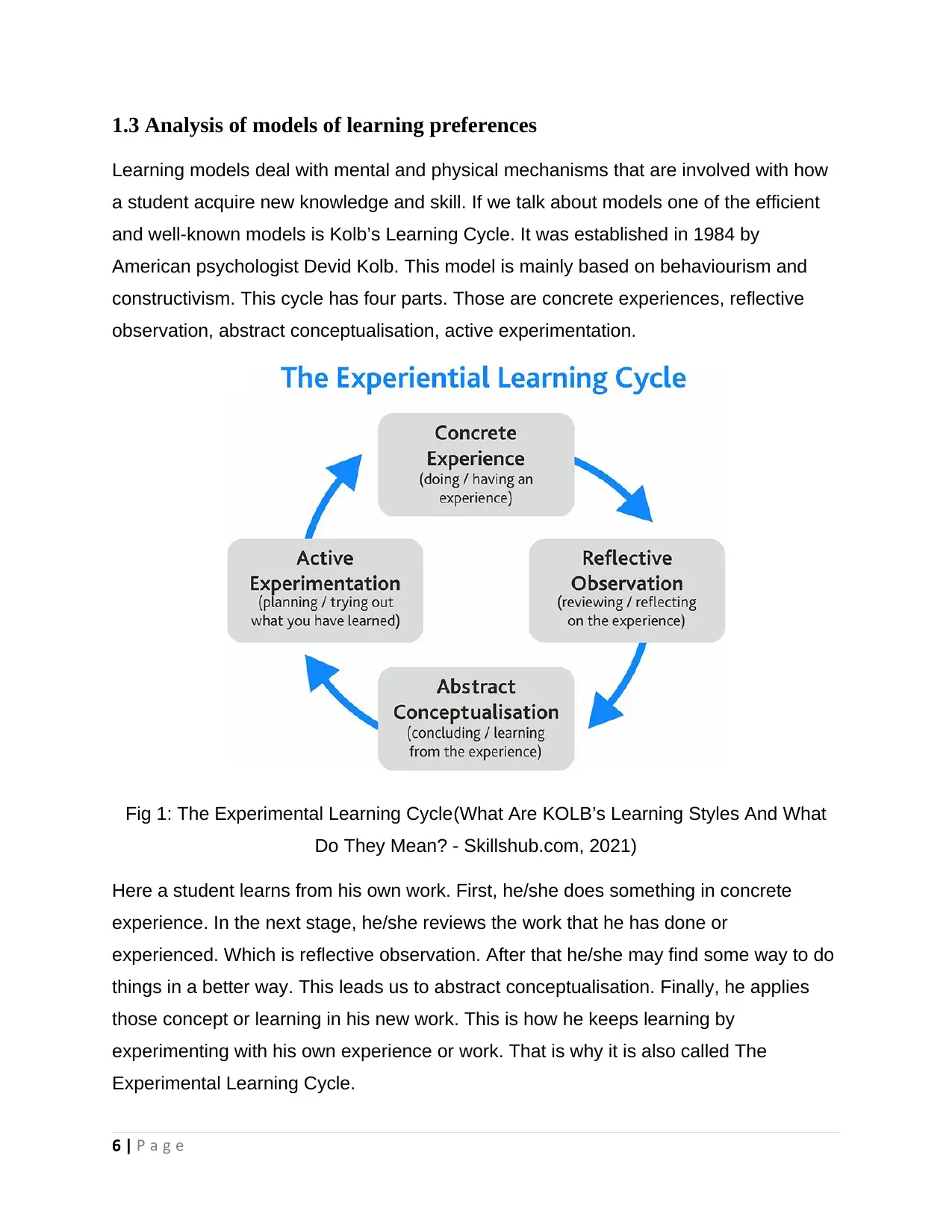
1.3 Analysis of models of learning preferences
Learning models deal with mental and physical mechanisms that are involved with how
a student acquire new knowledge and skill. If we talk about models one of the efficient
and well-known models is Kolb’s Learning Cycle. It was established in 1984 by
American psychologist Devid Kolb. This model is mainly based on behaviourism and
constructivism. This cycle has four parts. Those are concrete experiences, reflective
observation, abstract conceptualisation, active experimentation.
Fig 1: The Experimental Learning Cycle(What Are KOLB’s Learning Styles And What
Do They Mean? - Skillshub.com, 2021)
Here a student learns from his own work. First, he/she does something in concrete
experience. In the next stage, he/she reviews the work that he has done or
experienced. Which is reflective observation. After that he/she may find some way to do
things in a better way. This leads us to abstract conceptualisation. Finally, he applies
those concept or learning in his new work. This is how he keeps learning by
experimenting with his own experience or work. That is why it is also called The
Experimental Learning Cycle.
6 | P a g e
Learning models deal with mental and physical mechanisms that are involved with how
a student acquire new knowledge and skill. If we talk about models one of the efficient
and well-known models is Kolb’s Learning Cycle. It was established in 1984 by
American psychologist Devid Kolb. This model is mainly based on behaviourism and
constructivism. This cycle has four parts. Those are concrete experiences, reflective
observation, abstract conceptualisation, active experimentation.
Fig 1: The Experimental Learning Cycle(What Are KOLB’s Learning Styles And What
Do They Mean? - Skillshub.com, 2021)
Here a student learns from his own work. First, he/she does something in concrete
experience. In the next stage, he/she reviews the work that he has done or
experienced. Which is reflective observation. After that he/she may find some way to do
things in a better way. This leads us to abstract conceptualisation. Finally, he applies
those concept or learning in his new work. This is how he keeps learning by
experimenting with his own experience or work. That is why it is also called The
Experimental Learning Cycle.
6 | P a g e
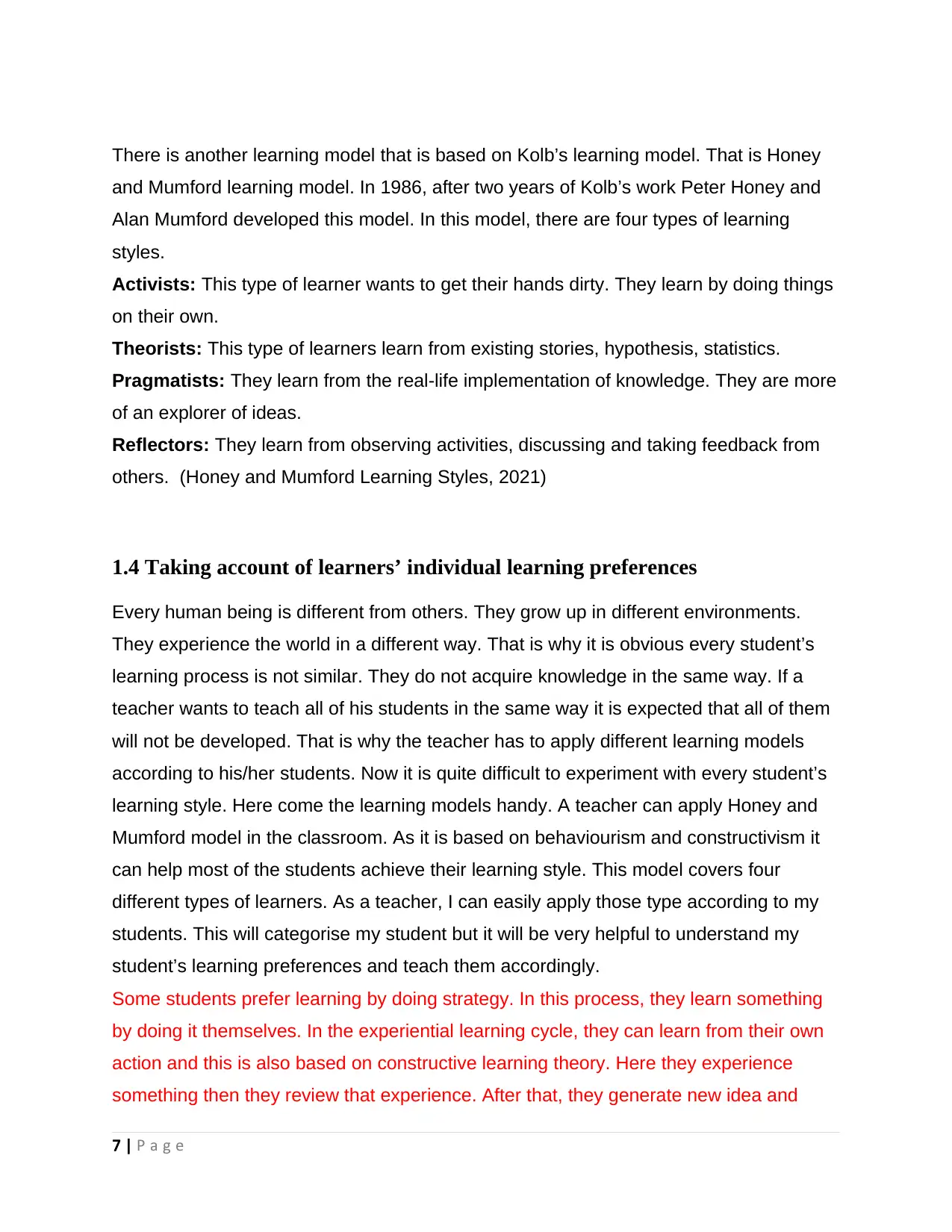
There is another learning model that is based on Kolb’s learning model. That is Honey
and Mumford learning model. In 1986, after two years of Kolb’s work Peter Honey and
Alan Mumford developed this model. In this model, there are four types of learning
styles.
Activists: This type of learner wants to get their hands dirty. They learn by doing things
on their own.
Theorists: This type of learners learn from existing stories, hypothesis, statistics.
Pragmatists: They learn from the real-life implementation of knowledge. They are more
of an explorer of ideas.
Reflectors: They learn from observing activities, discussing and taking feedback from
others. (Honey and Mumford Learning Styles, 2021)
1.4 Taking account of learners’ individual learning preferences
Every human being is different from others. They grow up in different environments.
They experience the world in a different way. That is why it is obvious every student’s
learning process is not similar. They do not acquire knowledge in the same way. If a
teacher wants to teach all of his students in the same way it is expected that all of them
will not be developed. That is why the teacher has to apply different learning models
according to his/her students. Now it is quite difficult to experiment with every student’s
learning style. Here come the learning models handy. A teacher can apply Honey and
Mumford model in the classroom. As it is based on behaviourism and constructivism it
can help most of the students achieve their learning style. This model covers four
different types of learners. As a teacher, I can easily apply those type according to my
students. This will categorise my student but it will be very helpful to understand my
student’s learning preferences and teach them accordingly.
Some students prefer learning by doing strategy. In this process, they learn something
by doing it themselves. In the experiential learning cycle, they can learn from their own
action and this is also based on constructive learning theory. Here they experience
something then they review that experience. After that, they generate new idea and
7 | P a g e
and Mumford learning model. In 1986, after two years of Kolb’s work Peter Honey and
Alan Mumford developed this model. In this model, there are four types of learning
styles.
Activists: This type of learner wants to get their hands dirty. They learn by doing things
on their own.
Theorists: This type of learners learn from existing stories, hypothesis, statistics.
Pragmatists: They learn from the real-life implementation of knowledge. They are more
of an explorer of ideas.
Reflectors: They learn from observing activities, discussing and taking feedback from
others. (Honey and Mumford Learning Styles, 2021)
1.4 Taking account of learners’ individual learning preferences
Every human being is different from others. They grow up in different environments.
They experience the world in a different way. That is why it is obvious every student’s
learning process is not similar. They do not acquire knowledge in the same way. If a
teacher wants to teach all of his students in the same way it is expected that all of them
will not be developed. That is why the teacher has to apply different learning models
according to his/her students. Now it is quite difficult to experiment with every student’s
learning style. Here come the learning models handy. A teacher can apply Honey and
Mumford model in the classroom. As it is based on behaviourism and constructivism it
can help most of the students achieve their learning style. This model covers four
different types of learners. As a teacher, I can easily apply those type according to my
students. This will categorise my student but it will be very helpful to understand my
student’s learning preferences and teach them accordingly.
Some students prefer learning by doing strategy. In this process, they learn something
by doing it themselves. In the experiential learning cycle, they can learn from their own
action and this is also based on constructive learning theory. Here they experience
something then they review that experience. After that, they generate new idea and
7 | P a g e
Paraphrase This Document
Need a fresh take? Get an instant paraphrase of this document with our AI Paraphraser
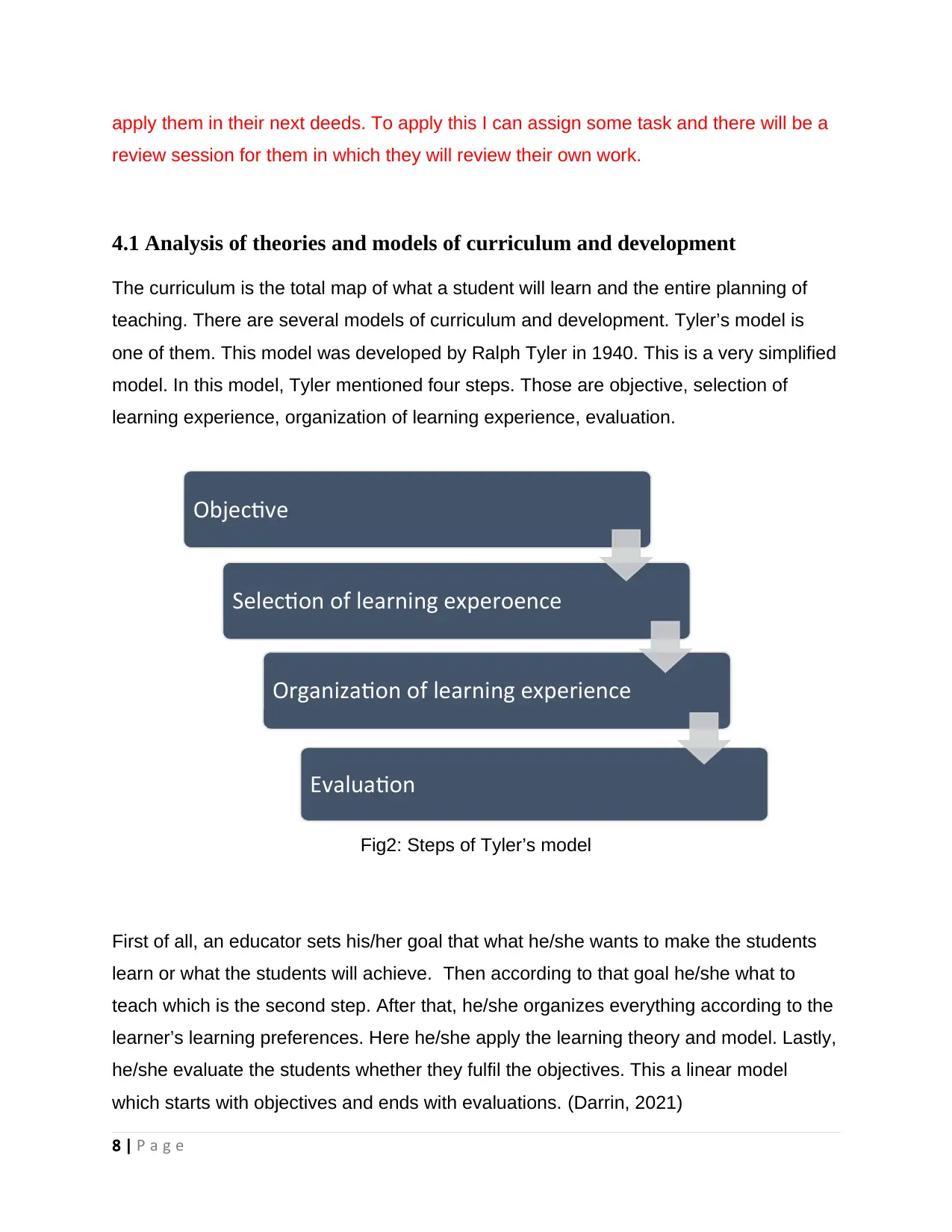
apply them in their next deeds. To apply this I can assign some task and there will be a
review session for them in which they will review their own work.
4.1 Analysis of theories and models of curriculum and development
The curriculum is the total map of what a student will learn and the entire planning of
teaching. There are several models of curriculum and development. Tyler’s model is
one of them. This model was developed by Ralph Tyler in 1940. This is a very simplified
model. In this model, Tyler mentioned four steps. Those are objective, selection of
learning experience, organization of learning experience, evaluation.
Fig2: Steps of Tyler’s model
First of all, an educator sets his/her goal that what he/she wants to make the students
learn or what the students will achieve. Then according to that goal he/she what to
teach which is the second step. After that, he/she organizes everything according to the
learner’s learning preferences. Here he/she apply the learning theory and model. Lastly,
he/she evaluate the students whether they fulfil the objectives. This a linear model
which starts with objectives and ends with evaluations. (Darrin, 2021)
8 | P a g e
Objective
Selection of learning experoence
Organization of learning experience
Evaluation
review session for them in which they will review their own work.
4.1 Analysis of theories and models of curriculum and development
The curriculum is the total map of what a student will learn and the entire planning of
teaching. There are several models of curriculum and development. Tyler’s model is
one of them. This model was developed by Ralph Tyler in 1940. This is a very simplified
model. In this model, Tyler mentioned four steps. Those are objective, selection of
learning experience, organization of learning experience, evaluation.
Fig2: Steps of Tyler’s model
First of all, an educator sets his/her goal that what he/she wants to make the students
learn or what the students will achieve. Then according to that goal he/she what to
teach which is the second step. After that, he/she organizes everything according to the
learner’s learning preferences. Here he/she apply the learning theory and model. Lastly,
he/she evaluate the students whether they fulfil the objectives. This a linear model
which starts with objectives and ends with evaluations. (Darrin, 2021)
8 | P a g e
Objective
Selection of learning experoence
Organization of learning experience
Evaluation
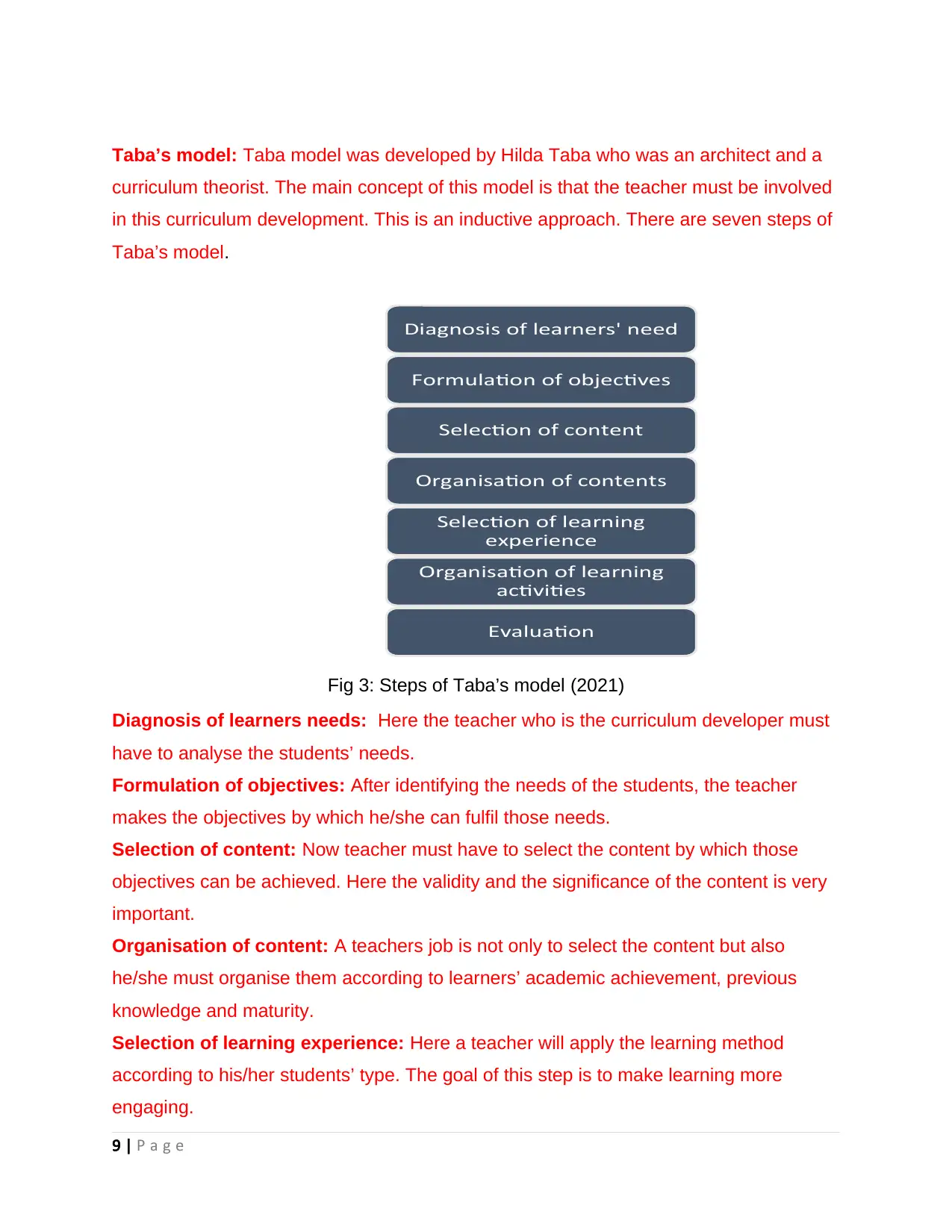
Taba’s model: Taba model was developed by Hilda Taba who was an architect and a
curriculum theorist. The main concept of this model is that the teacher must be involved
in this curriculum development. This is an inductive approach. There are seven steps of
Taba’s model.
Fig 3: Steps of Taba’s model (2021)
Diagnosis of learners needs: Here the teacher who is the curriculum developer must
have to analyse the students’ needs.
Formulation of objectives: After identifying the needs of the students, the teacher
makes the objectives by which he/she can fulfil those needs.
Selection of content: Now teacher must have to select the content by which those
objectives can be achieved. Here the validity and the significance of the content is very
important.
Organisation of content: A teachers job is not only to select the content but also
he/she must organise them according to learners’ academic achievement, previous
knowledge and maturity.
Selection of learning experience: Here a teacher will apply the learning method
according to his/her students’ type. The goal of this step is to make learning more
engaging.
9 | P a g e
Diagnosis of learners' need
Formulation of objectives
Selection of content
Organisation of contents
Selection of learning
experience
Organisation of learning
activities
Evaluation
curriculum theorist. The main concept of this model is that the teacher must be involved
in this curriculum development. This is an inductive approach. There are seven steps of
Taba’s model.
Fig 3: Steps of Taba’s model (2021)
Diagnosis of learners needs: Here the teacher who is the curriculum developer must
have to analyse the students’ needs.
Formulation of objectives: After identifying the needs of the students, the teacher
makes the objectives by which he/she can fulfil those needs.
Selection of content: Now teacher must have to select the content by which those
objectives can be achieved. Here the validity and the significance of the content is very
important.
Organisation of content: A teachers job is not only to select the content but also
he/she must organise them according to learners’ academic achievement, previous
knowledge and maturity.
Selection of learning experience: Here a teacher will apply the learning method
according to his/her students’ type. The goal of this step is to make learning more
engaging.
9 | P a g e
Diagnosis of learners' need
Formulation of objectives
Selection of content
Organisation of contents
Selection of learning
experience
Organisation of learning
activities
Evaluation
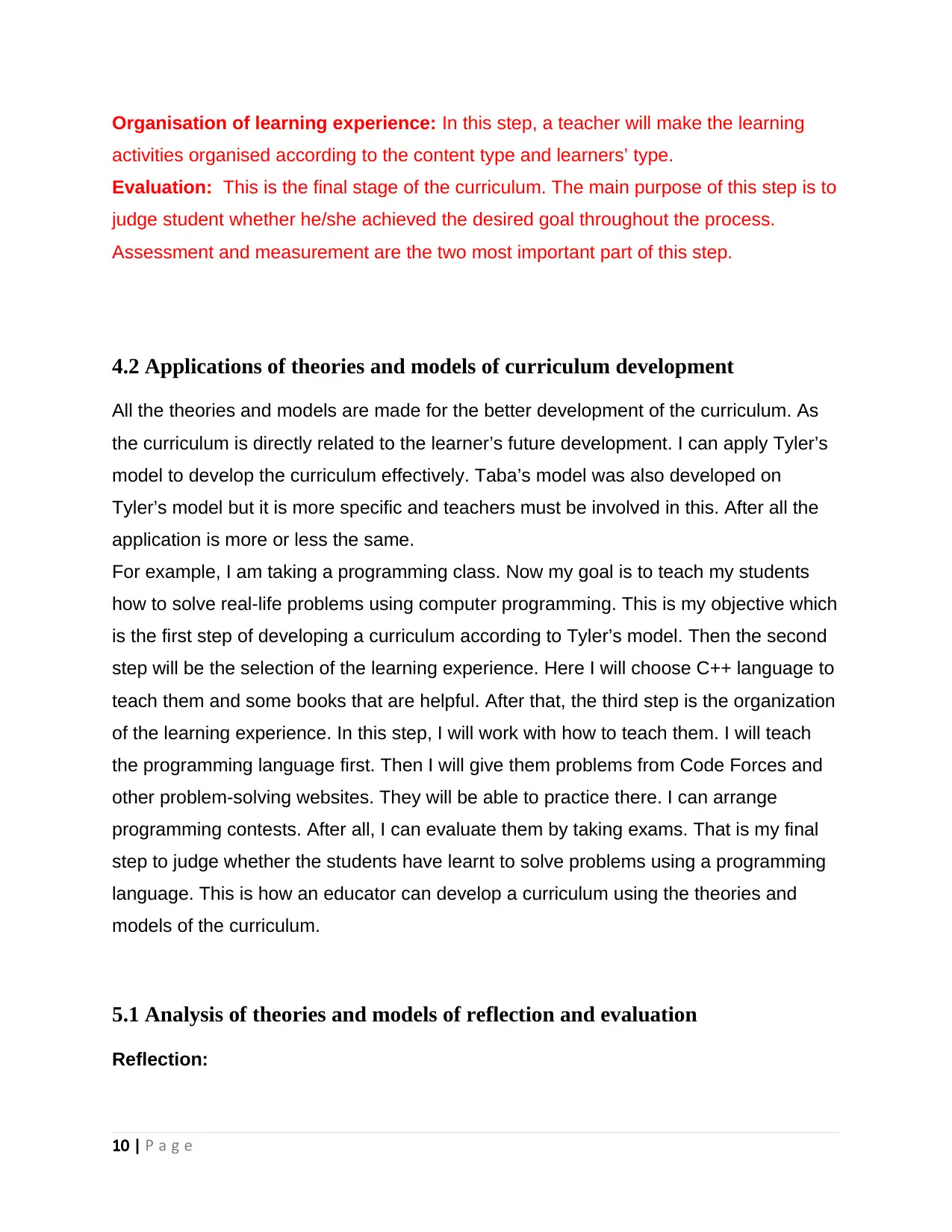
Organisation of learning experience: In this step, a teacher will make the learning
activities organised according to the content type and learners’ type.
Evaluation: This is the final stage of the curriculum. The main purpose of this step is to
judge student whether he/she achieved the desired goal throughout the process.
Assessment and measurement are the two most important part of this step.
4.2 Applications of theories and models of curriculum development
All the theories and models are made for the better development of the curriculum. As
the curriculum is directly related to the learner’s future development. I can apply Tyler’s
model to develop the curriculum effectively. Taba’s model was also developed on
Tyler’s model but it is more specific and teachers must be involved in this. After all the
application is more or less the same.
For example, I am taking a programming class. Now my goal is to teach my students
how to solve real-life problems using computer programming. This is my objective which
is the first step of developing a curriculum according to Tyler’s model. Then the second
step will be the selection of the learning experience. Here I will choose C++ language to
teach them and some books that are helpful. After that, the third step is the organization
of the learning experience. In this step, I will work with how to teach them. I will teach
the programming language first. Then I will give them problems from Code Forces and
other problem-solving websites. They will be able to practice there. I can arrange
programming contests. After all, I can evaluate them by taking exams. That is my final
step to judge whether the students have learnt to solve problems using a programming
language. This is how an educator can develop a curriculum using the theories and
models of the curriculum.
5.1 Analysis of theories and models of reflection and evaluation
Reflection:
10 | P a g e
activities organised according to the content type and learners’ type.
Evaluation: This is the final stage of the curriculum. The main purpose of this step is to
judge student whether he/she achieved the desired goal throughout the process.
Assessment and measurement are the two most important part of this step.
4.2 Applications of theories and models of curriculum development
All the theories and models are made for the better development of the curriculum. As
the curriculum is directly related to the learner’s future development. I can apply Tyler’s
model to develop the curriculum effectively. Taba’s model was also developed on
Tyler’s model but it is more specific and teachers must be involved in this. After all the
application is more or less the same.
For example, I am taking a programming class. Now my goal is to teach my students
how to solve real-life problems using computer programming. This is my objective which
is the first step of developing a curriculum according to Tyler’s model. Then the second
step will be the selection of the learning experience. Here I will choose C++ language to
teach them and some books that are helpful. After that, the third step is the organization
of the learning experience. In this step, I will work with how to teach them. I will teach
the programming language first. Then I will give them problems from Code Forces and
other problem-solving websites. They will be able to practice there. I can arrange
programming contests. After all, I can evaluate them by taking exams. That is my final
step to judge whether the students have learnt to solve problems using a programming
language. This is how an educator can develop a curriculum using the theories and
models of the curriculum.
5.1 Analysis of theories and models of reflection and evaluation
Reflection:
10 | P a g e
Secure Best Marks with AI Grader
Need help grading? Try our AI Grader for instant feedback on your assignments.
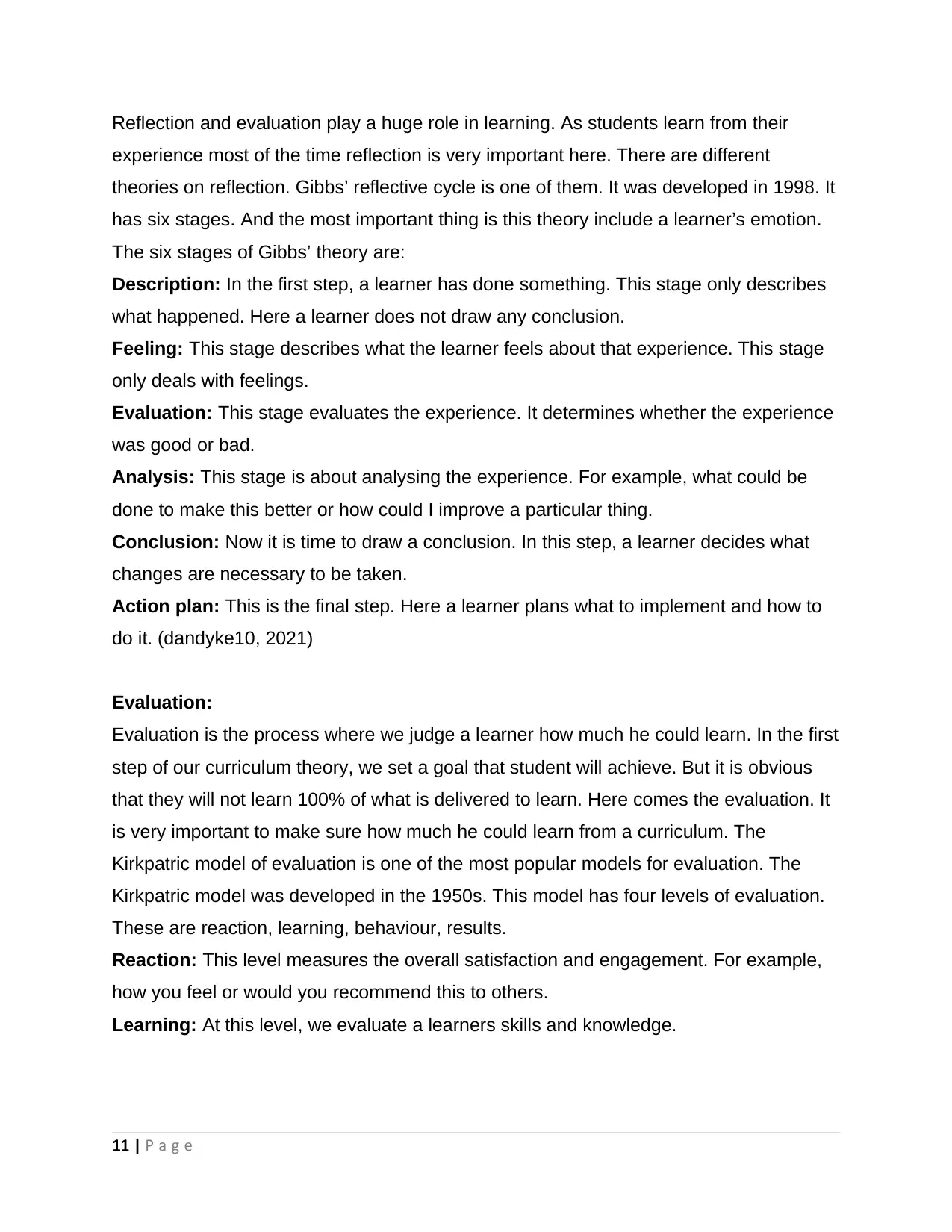
Reflection and evaluation play a huge role in learning. As students learn from their
experience most of the time reflection is very important here. There are different
theories on reflection. Gibbs’ reflective cycle is one of them. It was developed in 1998. It
has six stages. And the most important thing is this theory include a learner’s emotion.
The six stages of Gibbs’ theory are:
Description: In the first step, a learner has done something. This stage only describes
what happened. Here a learner does not draw any conclusion.
Feeling: This stage describes what the learner feels about that experience. This stage
only deals with feelings.
Evaluation: This stage evaluates the experience. It determines whether the experience
was good or bad.
Analysis: This stage is about analysing the experience. For example, what could be
done to make this better or how could I improve a particular thing.
Conclusion: Now it is time to draw a conclusion. In this step, a learner decides what
changes are necessary to be taken.
Action plan: This is the final step. Here a learner plans what to implement and how to
do it. (dandyke10, 2021)
Evaluation:
Evaluation is the process where we judge a learner how much he could learn. In the first
step of our curriculum theory, we set a goal that student will achieve. But it is obvious
that they will not learn 100% of what is delivered to learn. Here comes the evaluation. It
is very important to make sure how much he could learn from a curriculum. The
Kirkpatric model of evaluation is one of the most popular models for evaluation. The
Kirkpatric model was developed in the 1950s. This model has four levels of evaluation.
These are reaction, learning, behaviour, results.
Reaction: This level measures the overall satisfaction and engagement. For example,
how you feel or would you recommend this to others.
Learning: At this level, we evaluate a learners skills and knowledge.
11 | P a g e
experience most of the time reflection is very important here. There are different
theories on reflection. Gibbs’ reflective cycle is one of them. It was developed in 1998. It
has six stages. And the most important thing is this theory include a learner’s emotion.
The six stages of Gibbs’ theory are:
Description: In the first step, a learner has done something. This stage only describes
what happened. Here a learner does not draw any conclusion.
Feeling: This stage describes what the learner feels about that experience. This stage
only deals with feelings.
Evaluation: This stage evaluates the experience. It determines whether the experience
was good or bad.
Analysis: This stage is about analysing the experience. For example, what could be
done to make this better or how could I improve a particular thing.
Conclusion: Now it is time to draw a conclusion. In this step, a learner decides what
changes are necessary to be taken.
Action plan: This is the final step. Here a learner plans what to implement and how to
do it. (dandyke10, 2021)
Evaluation:
Evaluation is the process where we judge a learner how much he could learn. In the first
step of our curriculum theory, we set a goal that student will achieve. But it is obvious
that they will not learn 100% of what is delivered to learn. Here comes the evaluation. It
is very important to make sure how much he could learn from a curriculum. The
Kirkpatric model of evaluation is one of the most popular models for evaluation. The
Kirkpatric model was developed in the 1950s. This model has four levels of evaluation.
These are reaction, learning, behaviour, results.
Reaction: This level measures the overall satisfaction and engagement. For example,
how you feel or would you recommend this to others.
Learning: At this level, we evaluate a learners skills and knowledge.
11 | P a g e
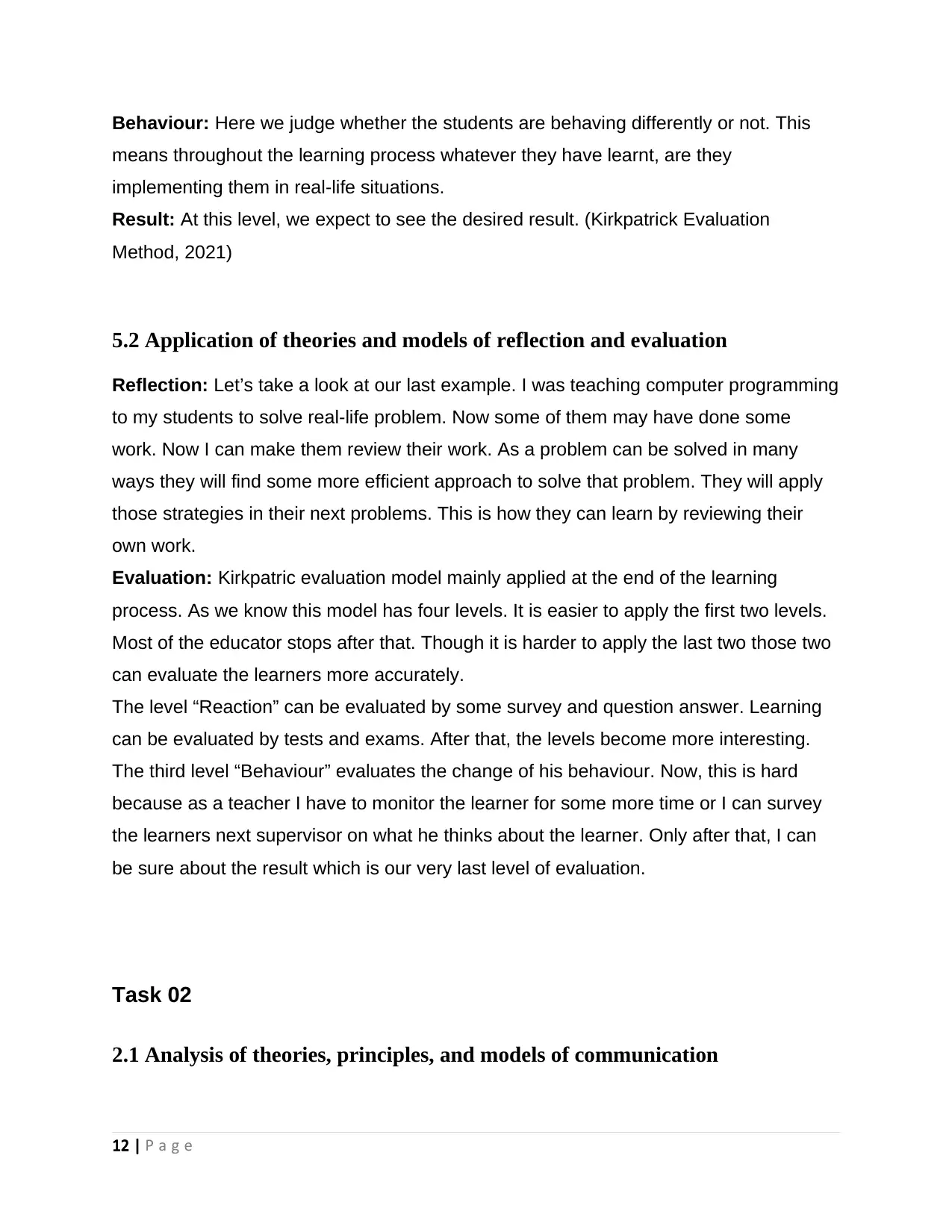
Behaviour: Here we judge whether the students are behaving differently or not. This
means throughout the learning process whatever they have learnt, are they
implementing them in real-life situations.
Result: At this level, we expect to see the desired result. (Kirkpatrick Evaluation
Method, 2021)
5.2 Application of theories and models of reflection and evaluation
Reflection: Let’s take a look at our last example. I was teaching computer programming
to my students to solve real-life problem. Now some of them may have done some
work. Now I can make them review their work. As a problem can be solved in many
ways they will find some more efficient approach to solve that problem. They will apply
those strategies in their next problems. This is how they can learn by reviewing their
own work.
Evaluation: Kirkpatric evaluation model mainly applied at the end of the learning
process. As we know this model has four levels. It is easier to apply the first two levels.
Most of the educator stops after that. Though it is harder to apply the last two those two
can evaluate the learners more accurately.
The level “Reaction” can be evaluated by some survey and question answer. Learning
can be evaluated by tests and exams. After that, the levels become more interesting.
The third level “Behaviour” evaluates the change of his behaviour. Now, this is hard
because as a teacher I have to monitor the learner for some more time or I can survey
the learners next supervisor on what he thinks about the learner. Only after that, I can
be sure about the result which is our very last level of evaluation.
Task 02
2.1 Analysis of theories, principles, and models of communication
12 | P a g e
means throughout the learning process whatever they have learnt, are they
implementing them in real-life situations.
Result: At this level, we expect to see the desired result. (Kirkpatrick Evaluation
Method, 2021)
5.2 Application of theories and models of reflection and evaluation
Reflection: Let’s take a look at our last example. I was teaching computer programming
to my students to solve real-life problem. Now some of them may have done some
work. Now I can make them review their work. As a problem can be solved in many
ways they will find some more efficient approach to solve that problem. They will apply
those strategies in their next problems. This is how they can learn by reviewing their
own work.
Evaluation: Kirkpatric evaluation model mainly applied at the end of the learning
process. As we know this model has four levels. It is easier to apply the first two levels.
Most of the educator stops after that. Though it is harder to apply the last two those two
can evaluate the learners more accurately.
The level “Reaction” can be evaluated by some survey and question answer. Learning
can be evaluated by tests and exams. After that, the levels become more interesting.
The third level “Behaviour” evaluates the change of his behaviour. Now, this is hard
because as a teacher I have to monitor the learner for some more time or I can survey
the learners next supervisor on what he thinks about the learner. Only after that, I can
be sure about the result which is our very last level of evaluation.
Task 02
2.1 Analysis of theories, principles, and models of communication
12 | P a g e
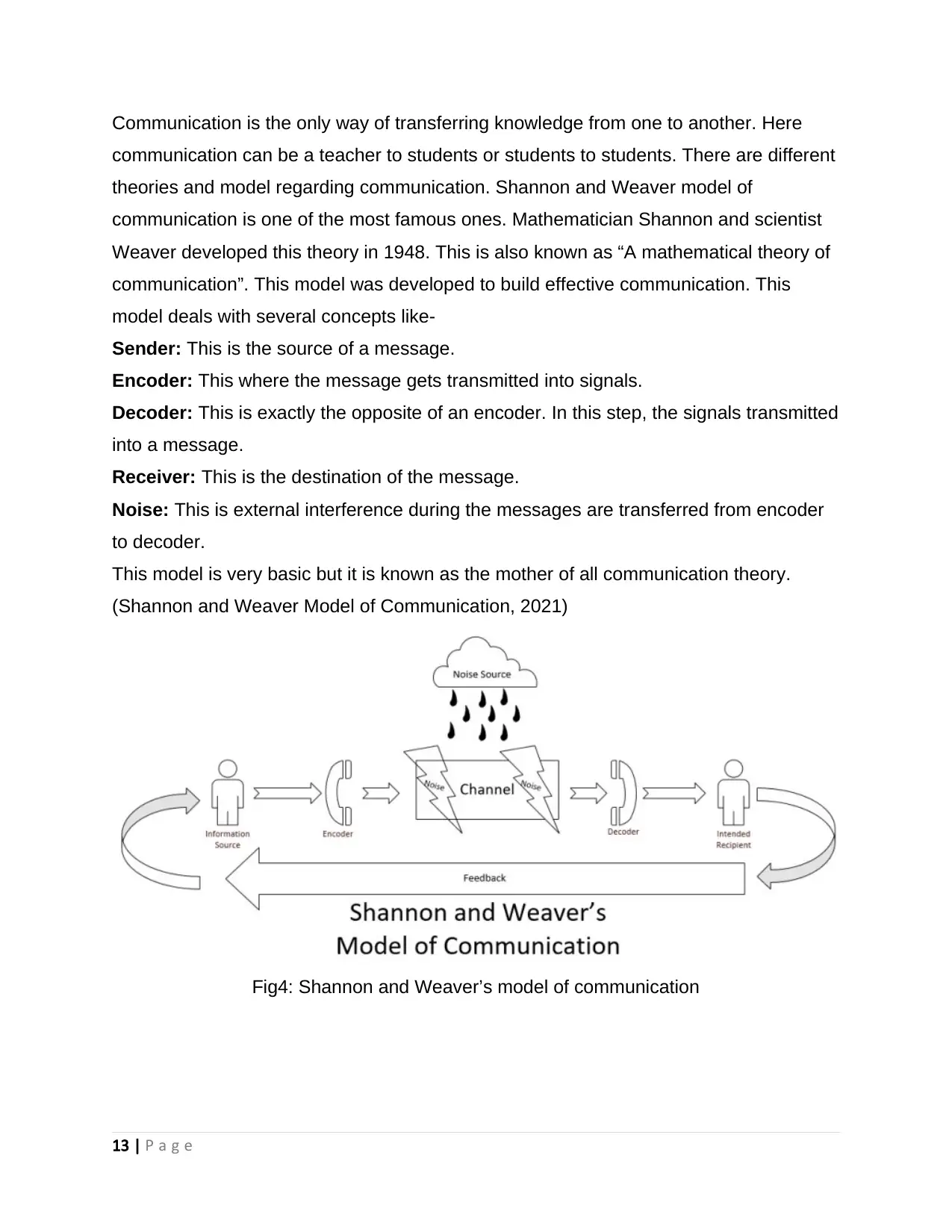
Communication is the only way of transferring knowledge from one to another. Here
communication can be a teacher to students or students to students. There are different
theories and model regarding communication. Shannon and Weaver model of
communication is one of the most famous ones. Mathematician Shannon and scientist
Weaver developed this theory in 1948. This is also known as “A mathematical theory of
communication”. This model was developed to build effective communication. This
model deals with several concepts like-
Sender: This is the source of a message.
Encoder: This where the message gets transmitted into signals.
Decoder: This is exactly the opposite of an encoder. In this step, the signals transmitted
into a message.
Receiver: This is the destination of the message.
Noise: This is external interference during the messages are transferred from encoder
to decoder.
This model is very basic but it is known as the mother of all communication theory.
(Shannon and Weaver Model of Communication, 2021)
Fig4: Shannon and Weaver’s model of communication
13 | P a g e
communication can be a teacher to students or students to students. There are different
theories and model regarding communication. Shannon and Weaver model of
communication is one of the most famous ones. Mathematician Shannon and scientist
Weaver developed this theory in 1948. This is also known as “A mathematical theory of
communication”. This model was developed to build effective communication. This
model deals with several concepts like-
Sender: This is the source of a message.
Encoder: This where the message gets transmitted into signals.
Decoder: This is exactly the opposite of an encoder. In this step, the signals transmitted
into a message.
Receiver: This is the destination of the message.
Noise: This is external interference during the messages are transferred from encoder
to decoder.
This model is very basic but it is known as the mother of all communication theory.
(Shannon and Weaver Model of Communication, 2021)
Fig4: Shannon and Weaver’s model of communication
13 | P a g e
Paraphrase This Document
Need a fresh take? Get an instant paraphrase of this document with our AI Paraphraser
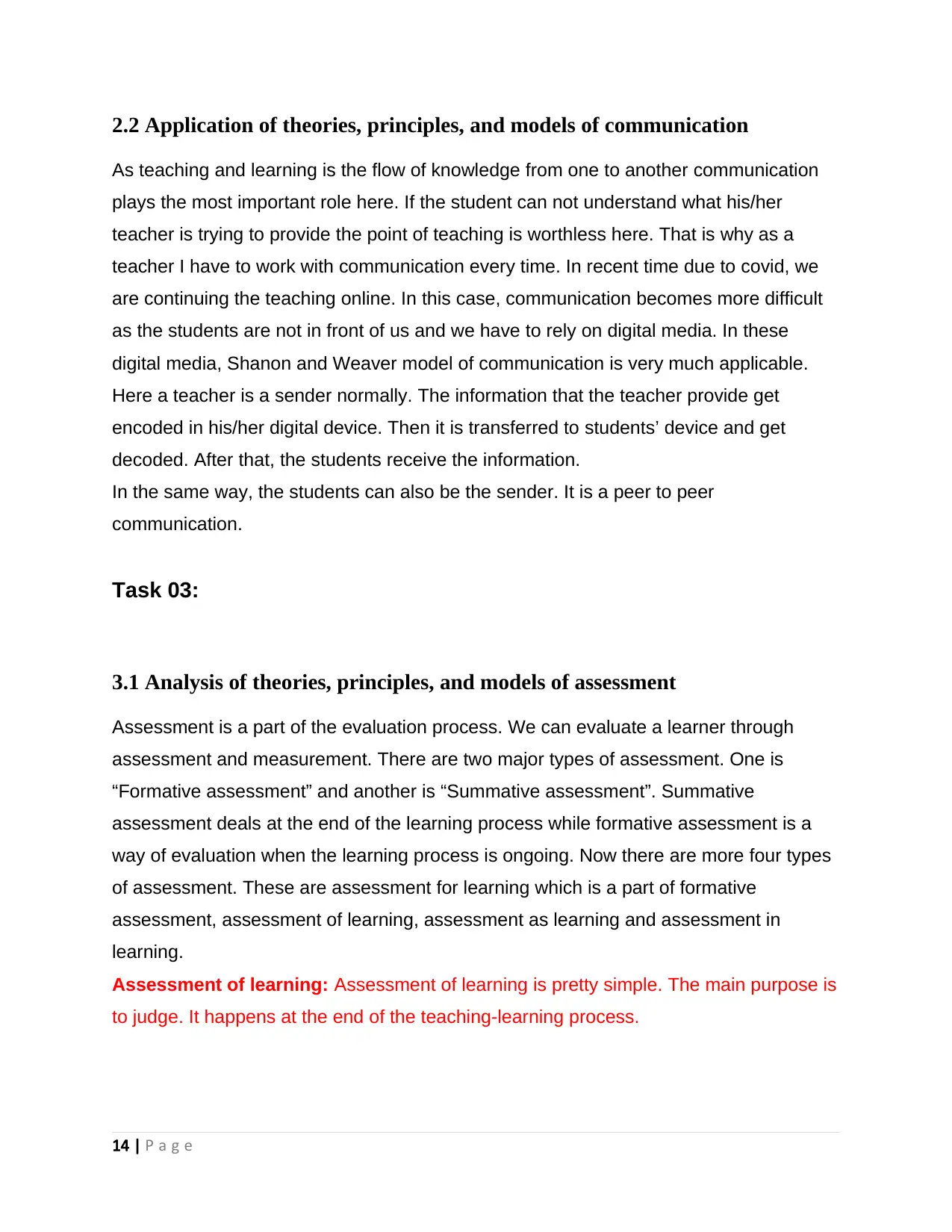
2.2 Application of theories, principles, and models of communication
As teaching and learning is the flow of knowledge from one to another communication
plays the most important role here. If the student can not understand what his/her
teacher is trying to provide the point of teaching is worthless here. That is why as a
teacher I have to work with communication every time. In recent time due to covid, we
are continuing the teaching online. In this case, communication becomes more difficult
as the students are not in front of us and we have to rely on digital media. In these
digital media, Shanon and Weaver model of communication is very much applicable.
Here a teacher is a sender normally. The information that the teacher provide get
encoded in his/her digital device. Then it is transferred to students’ device and get
decoded. After that, the students receive the information.
In the same way, the students can also be the sender. It is a peer to peer
communication.
Task 03:
3.1 Analysis of theories, principles, and models of assessment
Assessment is a part of the evaluation process. We can evaluate a learner through
assessment and measurement. There are two major types of assessment. One is
“Formative assessment” and another is “Summative assessment”. Summative
assessment deals at the end of the learning process while formative assessment is a
way of evaluation when the learning process is ongoing. Now there are more four types
of assessment. These are assessment for learning which is a part of formative
assessment, assessment of learning, assessment as learning and assessment in
learning.
Assessment of learning: Assessment of learning is pretty simple. The main purpose is
to judge. It happens at the end of the teaching-learning process.
14 | P a g e
As teaching and learning is the flow of knowledge from one to another communication
plays the most important role here. If the student can not understand what his/her
teacher is trying to provide the point of teaching is worthless here. That is why as a
teacher I have to work with communication every time. In recent time due to covid, we
are continuing the teaching online. In this case, communication becomes more difficult
as the students are not in front of us and we have to rely on digital media. In these
digital media, Shanon and Weaver model of communication is very much applicable.
Here a teacher is a sender normally. The information that the teacher provide get
encoded in his/her digital device. Then it is transferred to students’ device and get
decoded. After that, the students receive the information.
In the same way, the students can also be the sender. It is a peer to peer
communication.
Task 03:
3.1 Analysis of theories, principles, and models of assessment
Assessment is a part of the evaluation process. We can evaluate a learner through
assessment and measurement. There are two major types of assessment. One is
“Formative assessment” and another is “Summative assessment”. Summative
assessment deals at the end of the learning process while formative assessment is a
way of evaluation when the learning process is ongoing. Now there are more four types
of assessment. These are assessment for learning which is a part of formative
assessment, assessment of learning, assessment as learning and assessment in
learning.
Assessment of learning: Assessment of learning is pretty simple. The main purpose is
to judge. It happens at the end of the teaching-learning process.
14 | P a g e
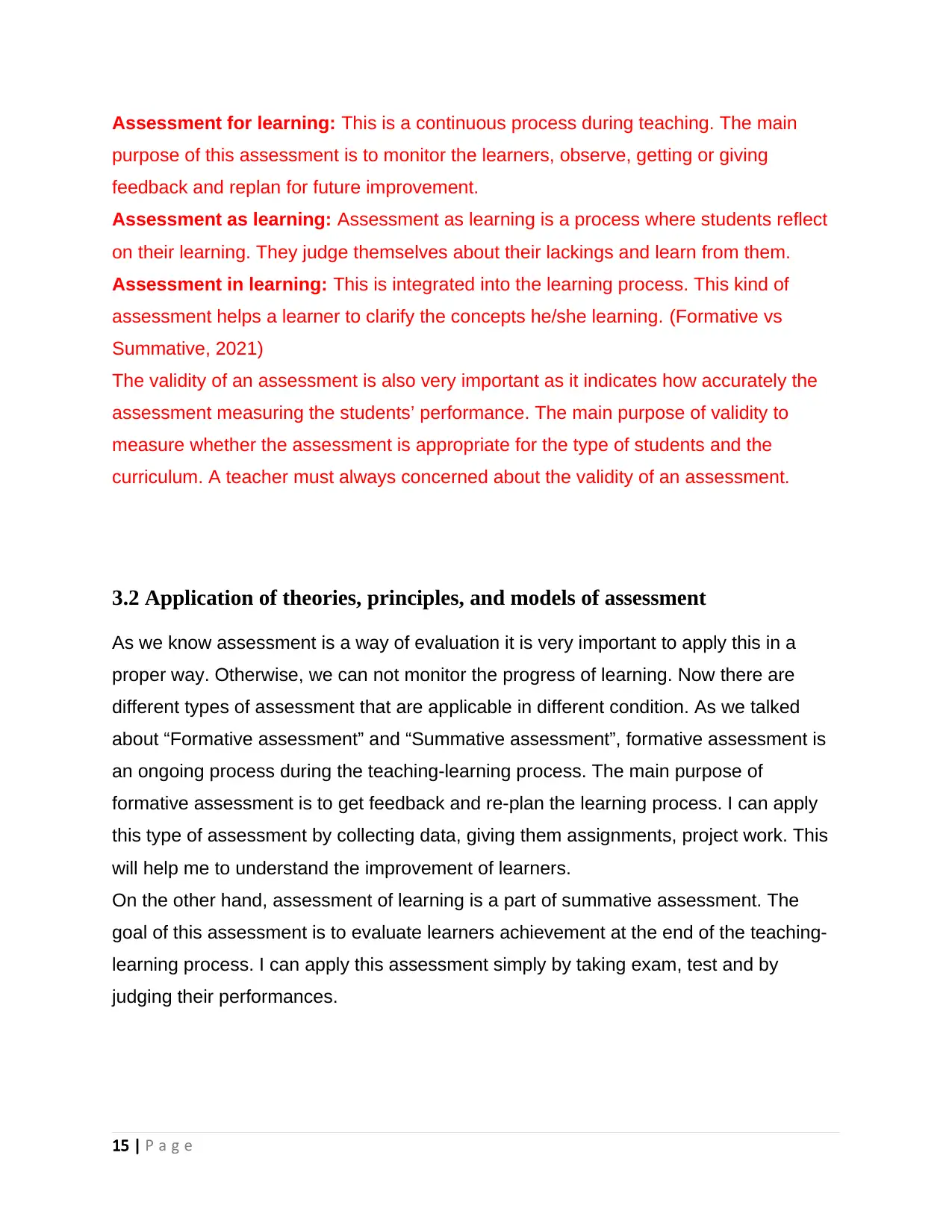
Assessment for learning: This is a continuous process during teaching. The main
purpose of this assessment is to monitor the learners, observe, getting or giving
feedback and replan for future improvement.
Assessment as learning: Assessment as learning is a process where students reflect
on their learning. They judge themselves about their lackings and learn from them.
Assessment in learning: This is integrated into the learning process. This kind of
assessment helps a learner to clarify the concepts he/she learning. (Formative vs
Summative, 2021)
The validity of an assessment is also very important as it indicates how accurately the
assessment measuring the students’ performance. The main purpose of validity to
measure whether the assessment is appropriate for the type of students and the
curriculum. A teacher must always concerned about the validity of an assessment.
3.2 Application of theories, principles, and models of assessment
As we know assessment is a way of evaluation it is very important to apply this in a
proper way. Otherwise, we can not monitor the progress of learning. Now there are
different types of assessment that are applicable in different condition. As we talked
about “Formative assessment” and “Summative assessment”, formative assessment is
an ongoing process during the teaching-learning process. The main purpose of
formative assessment is to get feedback and re-plan the learning process. I can apply
this type of assessment by collecting data, giving them assignments, project work. This
will help me to understand the improvement of learners.
On the other hand, assessment of learning is a part of summative assessment. The
goal of this assessment is to evaluate learners achievement at the end of the teaching-
learning process. I can apply this assessment simply by taking exam, test and by
judging their performances.
15 | P a g e
purpose of this assessment is to monitor the learners, observe, getting or giving
feedback and replan for future improvement.
Assessment as learning: Assessment as learning is a process where students reflect
on their learning. They judge themselves about their lackings and learn from them.
Assessment in learning: This is integrated into the learning process. This kind of
assessment helps a learner to clarify the concepts he/she learning. (Formative vs
Summative, 2021)
The validity of an assessment is also very important as it indicates how accurately the
assessment measuring the students’ performance. The main purpose of validity to
measure whether the assessment is appropriate for the type of students and the
curriculum. A teacher must always concerned about the validity of an assessment.
3.2 Application of theories, principles, and models of assessment
As we know assessment is a way of evaluation it is very important to apply this in a
proper way. Otherwise, we can not monitor the progress of learning. Now there are
different types of assessment that are applicable in different condition. As we talked
about “Formative assessment” and “Summative assessment”, formative assessment is
an ongoing process during the teaching-learning process. The main purpose of
formative assessment is to get feedback and re-plan the learning process. I can apply
this type of assessment by collecting data, giving them assignments, project work. This
will help me to understand the improvement of learners.
On the other hand, assessment of learning is a part of summative assessment. The
goal of this assessment is to evaluate learners achievement at the end of the teaching-
learning process. I can apply this assessment simply by taking exam, test and by
judging their performances.
15 | P a g e
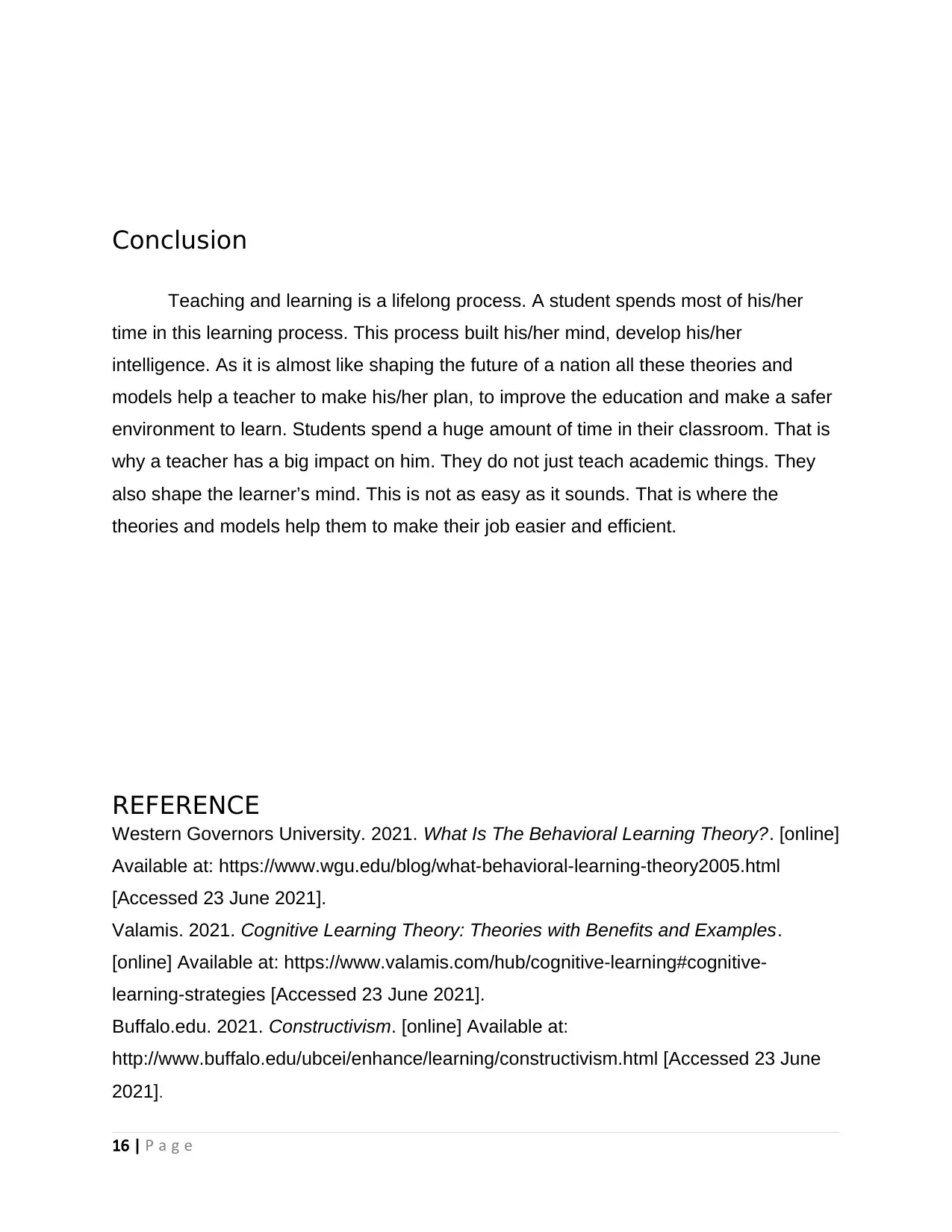
Conclusion
Teaching and learning is a lifelong process. A student spends most of his/her
time in this learning process. This process built his/her mind, develop his/her
intelligence. As it is almost like shaping the future of a nation all these theories and
models help a teacher to make his/her plan, to improve the education and make a safer
environment to learn. Students spend a huge amount of time in their classroom. That is
why a teacher has a big impact on him. They do not just teach academic things. They
also shape the learner’s mind. This is not as easy as it sounds. That is where the
theories and models help them to make their job easier and efficient.
REFERENCE
Western Governors University. 2021. What Is The Behavioral Learning Theory?. [online]
Available at: https://www.wgu.edu/blog/what-behavioral-learning-theory2005.html
[Accessed 23 June 2021].
Valamis. 2021. Cognitive Learning Theory: Theories with Benefits and Examples.
[online] Available at: https://www.valamis.com/hub/cognitive-learning#cognitive-
learning-strategies [Accessed 23 June 2021].
Buffalo.edu. 2021. Constructivism. [online] Available at:
http://www.buffalo.edu/ubcei/enhance/learning/constructivism.html [Accessed 23 June
2021].
16 | P a g e
Teaching and learning is a lifelong process. A student spends most of his/her
time in this learning process. This process built his/her mind, develop his/her
intelligence. As it is almost like shaping the future of a nation all these theories and
models help a teacher to make his/her plan, to improve the education and make a safer
environment to learn. Students spend a huge amount of time in their classroom. That is
why a teacher has a big impact on him. They do not just teach academic things. They
also shape the learner’s mind. This is not as easy as it sounds. That is where the
theories and models help them to make their job easier and efficient.
REFERENCE
Western Governors University. 2021. What Is The Behavioral Learning Theory?. [online]
Available at: https://www.wgu.edu/blog/what-behavioral-learning-theory2005.html
[Accessed 23 June 2021].
Valamis. 2021. Cognitive Learning Theory: Theories with Benefits and Examples.
[online] Available at: https://www.valamis.com/hub/cognitive-learning#cognitive-
learning-strategies [Accessed 23 June 2021].
Buffalo.edu. 2021. Constructivism. [online] Available at:
http://www.buffalo.edu/ubcei/enhance/learning/constructivism.html [Accessed 23 June
2021].
16 | P a g e
Secure Best Marks with AI Grader
Need help grading? Try our AI Grader for instant feedback on your assignments.
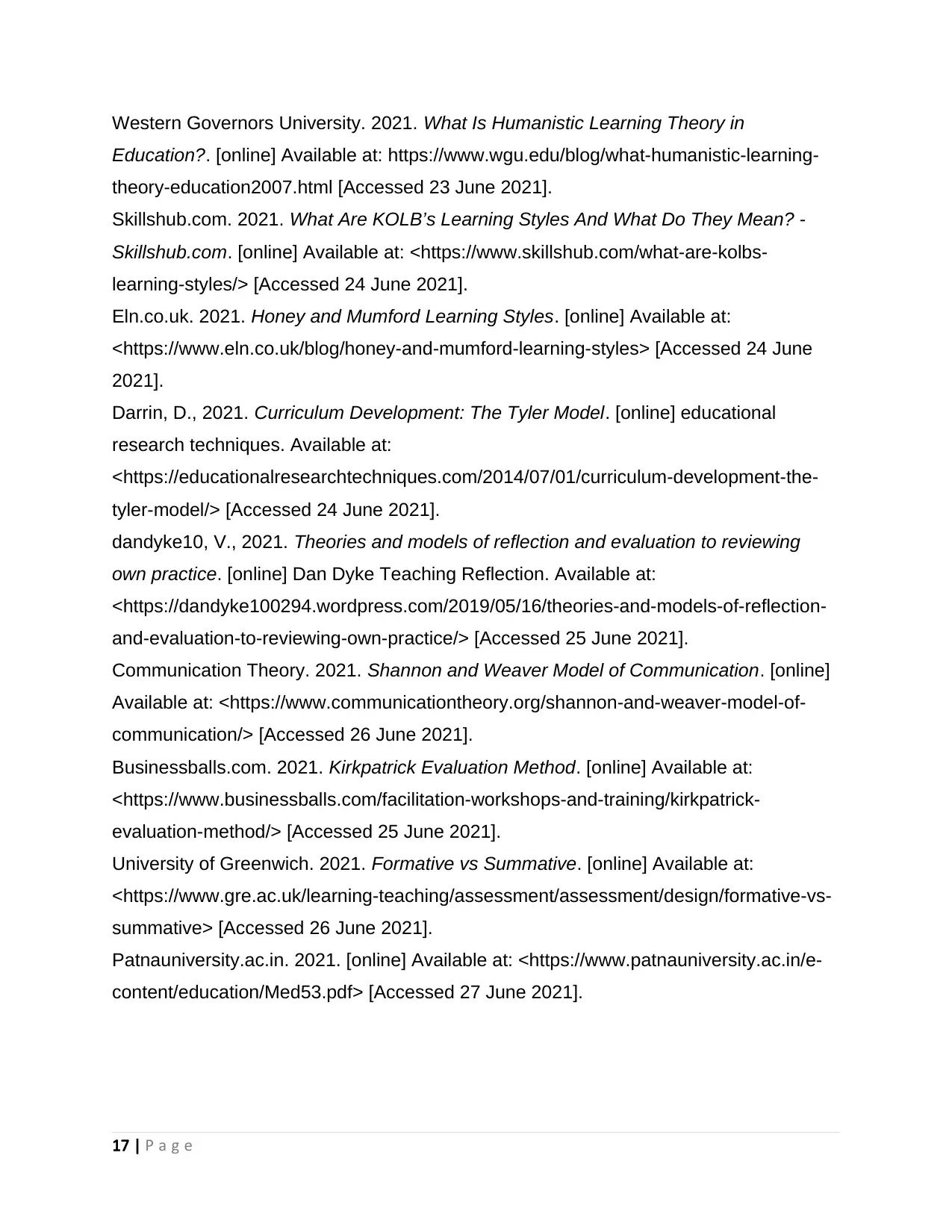
Western Governors University. 2021. What Is Humanistic Learning Theory in
Education?. [online] Available at: https://www.wgu.edu/blog/what-humanistic-learning-
theory-education2007.html [Accessed 23 June 2021].
Skillshub.com. 2021. What Are KOLB’s Learning Styles And What Do They Mean? -
Skillshub.com. [online] Available at: <https://www.skillshub.com/what-are-kolbs-
learning-styles/> [Accessed 24 June 2021].
Eln.co.uk. 2021. Honey and Mumford Learning Styles. [online] Available at:
<https://www.eln.co.uk/blog/honey-and-mumford-learning-styles> [Accessed 24 June
2021].
Darrin, D., 2021. Curriculum Development: The Tyler Model. [online] educational
research techniques. Available at:
<https://educationalresearchtechniques.com/2014/07/01/curriculum-development-the-
tyler-model/> [Accessed 24 June 2021].
dandyke10, V., 2021. Theories and models of reflection and evaluation to reviewing
own practice. [online] Dan Dyke Teaching Reflection. Available at:
<https://dandyke100294.wordpress.com/2019/05/16/theories-and-models-of-reflection-
and-evaluation-to-reviewing-own-practice/> [Accessed 25 June 2021].
Communication Theory. 2021. Shannon and Weaver Model of Communication. [online]
Available at: <https://www.communicationtheory.org/shannon-and-weaver-model-of-
communication/> [Accessed 26 June 2021].
Businessballs.com. 2021. Kirkpatrick Evaluation Method. [online] Available at:
<https://www.businessballs.com/facilitation-workshops-and-training/kirkpatrick-
evaluation-method/> [Accessed 25 June 2021].
University of Greenwich. 2021. Formative vs Summative. [online] Available at:
<https://www.gre.ac.uk/learning-teaching/assessment/assessment/design/formative-vs-
summative> [Accessed 26 June 2021].
Patnauniversity.ac.in. 2021. [online] Available at: <https://www.patnauniversity.ac.in/e-
content/education/Med53.pdf> [Accessed 27 June 2021].
17 | P a g e
Education?. [online] Available at: https://www.wgu.edu/blog/what-humanistic-learning-
theory-education2007.html [Accessed 23 June 2021].
Skillshub.com. 2021. What Are KOLB’s Learning Styles And What Do They Mean? -
Skillshub.com. [online] Available at: <https://www.skillshub.com/what-are-kolbs-
learning-styles/> [Accessed 24 June 2021].
Eln.co.uk. 2021. Honey and Mumford Learning Styles. [online] Available at:
<https://www.eln.co.uk/blog/honey-and-mumford-learning-styles> [Accessed 24 June
2021].
Darrin, D., 2021. Curriculum Development: The Tyler Model. [online] educational
research techniques. Available at:
<https://educationalresearchtechniques.com/2014/07/01/curriculum-development-the-
tyler-model/> [Accessed 24 June 2021].
dandyke10, V., 2021. Theories and models of reflection and evaluation to reviewing
own practice. [online] Dan Dyke Teaching Reflection. Available at:
<https://dandyke100294.wordpress.com/2019/05/16/theories-and-models-of-reflection-
and-evaluation-to-reviewing-own-practice/> [Accessed 25 June 2021].
Communication Theory. 2021. Shannon and Weaver Model of Communication. [online]
Available at: <https://www.communicationtheory.org/shannon-and-weaver-model-of-
communication/> [Accessed 26 June 2021].
Businessballs.com. 2021. Kirkpatrick Evaluation Method. [online] Available at:
<https://www.businessballs.com/facilitation-workshops-and-training/kirkpatrick-
evaluation-method/> [Accessed 25 June 2021].
University of Greenwich. 2021. Formative vs Summative. [online] Available at:
<https://www.gre.ac.uk/learning-teaching/assessment/assessment/design/formative-vs-
summative> [Accessed 26 June 2021].
Patnauniversity.ac.in. 2021. [online] Available at: <https://www.patnauniversity.ac.in/e-
content/education/Med53.pdf> [Accessed 27 June 2021].
17 | P a g e
1 out of 17
Related Documents
Your All-in-One AI-Powered Toolkit for Academic Success.
+13062052269
info@desklib.com
Available 24*7 on WhatsApp / Email
![[object Object]](/_next/static/media/star-bottom.7253800d.svg)
Unlock your academic potential
© 2024 | Zucol Services PVT LTD | All rights reserved.




